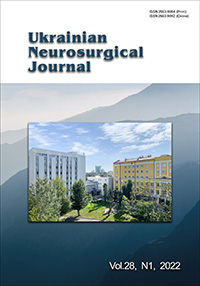Changing the concept of surgical treatment of the brachial plexus traumatic injuries
DOI:
https://doi.org/10.25305/unj.248108Keywords:
brachial plexus, trauma, surgical treatment, nerve transfer, nerve graftingAbstract
Objective: the objective of this study was to retrospectively analyze the change in the surgical strategy (SS) of brachial plexus injuries (BPI), the outcomes of different SS and the factors that influenced the establishing process of a new SS in a single surgical centre in Kyiv, Ukraine.
Materials and Methods. 148 patients (mean age 29.5) received 76 neurolysis (N), 14 grafting (G) and 58 nerve transfer (NT) surgeries after a mean 7.4 months following BPI. 29 patients received NT of n. phrenicus, 7 –ulnar nerve fascicles, 9 – lateral pectoral nerve, 7 – medial pectoral nerve to musculocutaneous nerve aimed to restore active elbow flexion. Six other patients received NT of ipsilateral extraplexal motor nerves. The follow-up period included neurological examination (MRC Scale), electromyographic examination and angular deviation in the elbow joint during recovered active elbow flexion. 148 patients were retrospectively divided into two groups A (102 patients, received surgeries from surgical team #1) and B (46 patients, received surgeries from surgical team #2). The SS used in each group and its change with time was analyzed during the 6-year span.
Results. 41 patients (70.7%) showed recovery of effective power (Ep) (M4-5) of biceps brachii muscle (BB) after NT. 14 patients (18.4%) showed recovery of Ep of BB after N. 4 patients (28.6%) showed recovery of Ep of BB after G. Overall Group A patients received 55 NT, Group B – 3 NT. The number of NT among Group A patients increased in 2013-2019 from 31% to 100% with overall efficacy of NT increased from 50% to 83%.
Conclusions. SS of BPI changed only for Group A patients – N was completely replaced by NT in 2019. For Group B patients N remained SS of choice. The establishing of new SS was influenced by four factors (time, anatomy of injury, donor nerves, radiological findings). The factors being processed, allowed us to define optimal time, effective donors and non-reliability of radiology at BPI. We state that it is only matter of own experience, based on the thorough analysis of the technique, that brings positive outcomes after new SS has been adopted.
References
Domeshek LF, Novak CB, Patterson JMM, Hasak JM, Yee A, Kahn LC, Mackinnon SE. Nerve Transfers-A Paradigm Shift in the Reconstructive Ladder. Plast Reconstr Surg Glob Open. 2019 Jun 25;7(6):e2290. doi: 10.1097/GOX.0000000000002290.
Moore AM. Nerve Transfers to Restore upper Extremity Function: A Paradigm Shift. Front Neurol. 2014 Mar 31;5:40. doi: 10.3389/fneur.2014.00040.
Hems T. Nerve transfers for traumatic brachial plexus injury: advantages and problems. J Hand Microsurg. 2011 Jun;3(1):6-10. doi: 10.1007/s12593-011-0031-1.
Washington University School of Medicine in St. Louis. Surgical Education. Learn Surgery. Category: Surgical Procedures. https://surgicaleducation.wustl.edu/category/surgical-procedures
Chuang DC. Brachial plexus reconstruction based on the new definition of level of injury. Injury. 2008 Sep;39 Suppl 3:S23-9. doi: 10.1016/j.injury.2008.05.012.
Hsueh YH, Tu YK. Surgical reconstructions for adult brachial plexus injuries. Part I: Treatments for combined C5 and C6 injuries, with or without C7 injuries. Injury. 2020 Apr;51(4):787-803. doi: 10.1016/j.injury.2020.02.076.
Pirela-Cruz M, Mujadzić M, Kanlić E. Brachial plexus treatment. Bosn J Basic Med Sci. 2005 Aug;5(3):7-15. doi: 10.17305/bjbms.2005.3264.
Matthews WB. Aids to the examination of the peripheral nervous system. J Neurol Sci. 1977;33(1-2):299.
Gates DH, Walters LS, Cowley J, Wilken JM, Resnik L. Range of Motion Requirements for Upper-Limb Activities of Daily Living. Am J Occup Ther. 2016 Jan-Feb;70(1):7001350010p1-7001350010p10. doi: 10.5014/ajot.2016.015487.
Martin E, Senders JT, DiRisio AC, Smith TR, Broekman MLD. Timing of surgery in traumatic brachial plexus injury: a systematic review. J Neurosurg. 2018 May 1:1-13. doi: 10.3171/2018.1.JNS172068.
Downloads
Published
How to Cite
Issue
Section
License
Copyright (c) 2022 Vitalii I. Tsymbaliuk, Alexander A. Gatskiy, Ihor B. Tretyak, Iaroslav V. Tsymbaliuk, Albina I. Tretiakova, Jiang Hao

This work is licensed under a Creative Commons Attribution 4.0 International License.
Ukrainian Neurosurgical Journal abides by the CREATIVE COMMONS copyright rights and permissions for open access journals.
Authors, who are published in this Journal, agree to the following conditions:
1. The authors reserve the right to authorship of the work and pass the first publication right of this work to the Journal under the terms of Creative Commons Attribution License, which allows others to freely distribute the published research with the obligatory reference to the authors of the original work and the first publication of the work in this Journal.
2. The authors have the right to conclude separate supplement agreements that relate to non-exclusive work distribution in the form of which it has been published by the Journal (for example, to upload the work to the online storage of the Journal or publish it as part of a monograph), provided that the reference to the first publication of the work in this Journal is included.









